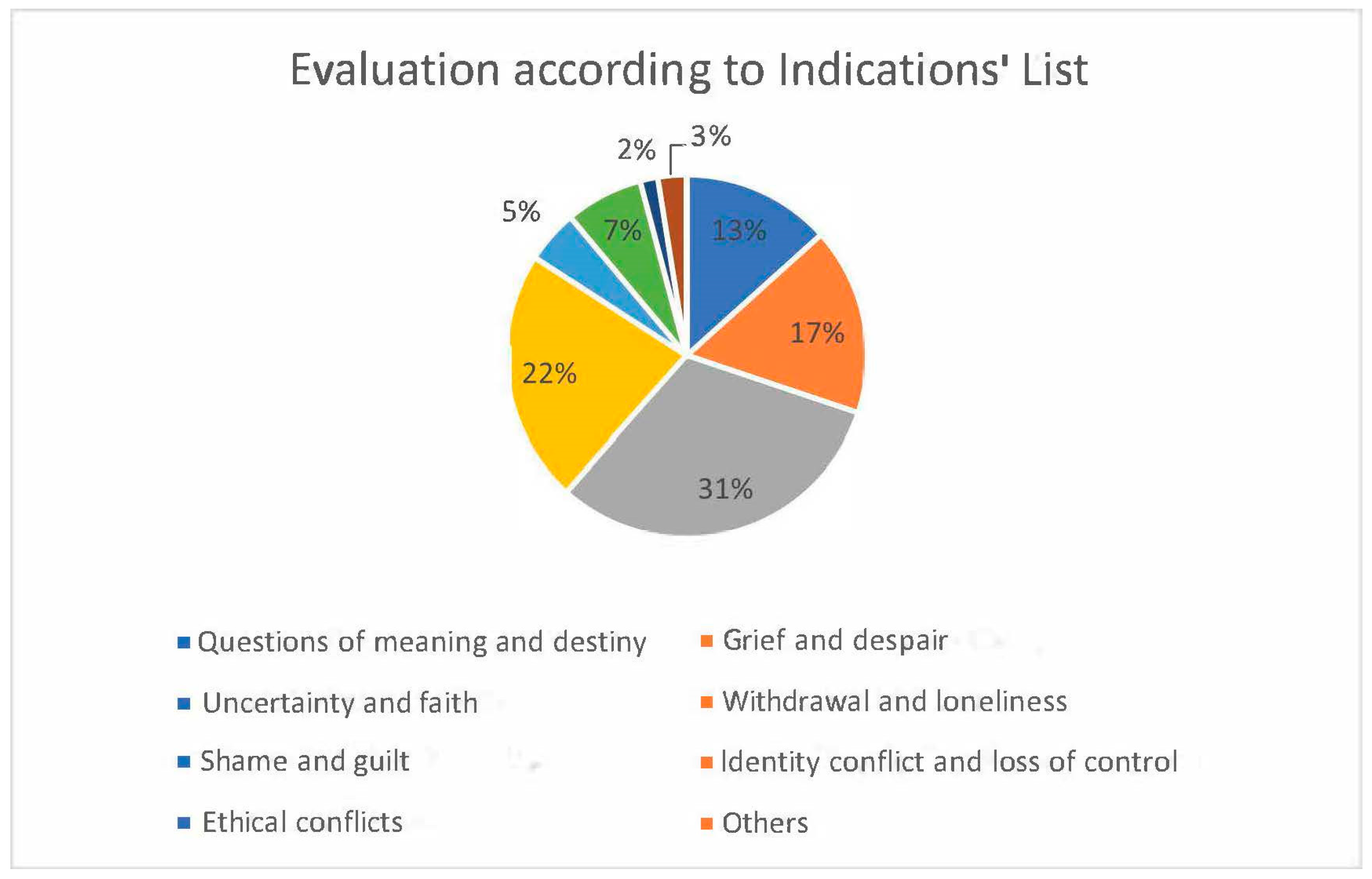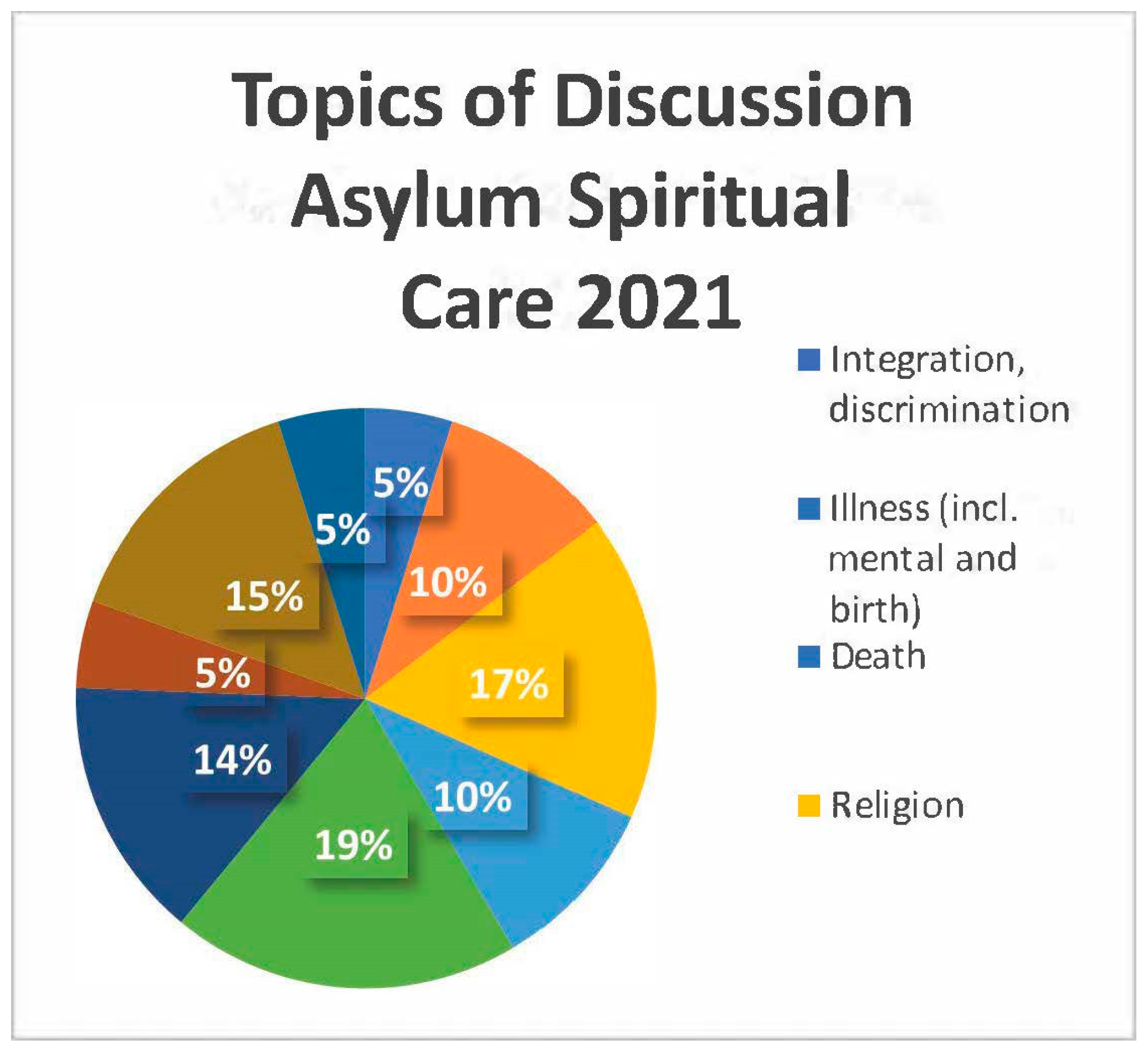Diaconia and Interreligious Cooperation in Switzerland
Abstract
1. Introduction1
2. Theoretical Approach
2.1. Religious Landscape of Switzerland
2.2. Cultural Coherence of Helping Actions
2.3. Diaconal Spiritual Care
2.4. From Intercultural Communication to Transcultural Practice
3. First Practical Experience
3.1. First Imam as Chaplain at Zurich University Hospital
1. Religious beliefs are part of the foundation of society.
2. Religious communities contribute to public peace.
3. Religious symbols visible in the public sphere are subject to the state’s legal system.
4. The state legal system applies to all religious communities.
5. The state legal order of Switzerland and the Canton of Zurich is determined by a democratic-liberal culture.
6. The recognition under public law of the Protestant Reformed Church, the Roman Catholic Church of the Canton of Zurich, the Christian Catholic Church, and the two Jewish communities has been established.
From my point of view, four aspects of this political initiative are worth highlighting for interreligious cooperation. The initiative proceeds from pragmatic solutions.7. Clear foundations must be created with regard to the religious communities that are not recognized under constitutional law.7
“It (diversity, add. CS) is an opportunity for every citizen because everyone is given the chance to participate in society. So, it is also for me, with all my backgrounds that I bring and that make me a personality, a recognition. Muslim, Imam, chaplain, Swiss, Bosnian, Toggenburg, Zurich, son, grandson, uncle, husband, father, friend, and now army chaplain. Behind each of these designations, there is always a human being. Because only the human being manages to be so many things in one person”
3.2. Muslim Spiritual Care in Asylum Centers in Switzerland
- Muslim spiritual care is a “supplement” to the spiritual care offered by the national churches.
- Muslim chaplains are a valuable resource: their services are gladly used by asylum seekers; the staff appreciates their religious, cultural, and linguistic competencies; the Christian chaplains welcome their presence.
- The cooperation with Christian chaplains is positive.
- The costs of CHF 450,000/year will be included in the proposal for the revision of the Asylum Law.
“Meanwhile, the Muslim chaplaincy in the canton of Zurich is available to public institutions with a team of 17 chaplains 365 days during 24 h. The number of spiritual care missions in various Zurich institutions has been growing steadily since the founding of the association. In 2020, despite numerous corona-related restrictions, a total of 216 such missions were carried out. Since the corona crisis, the association has offered internet and telephone spiritual care. In 2020, for the first time, 25 spiritual care conversations were conducted via e-mail and 80 spiritual care conversations via telephone. Within the framework of asylum spiritual care, a total of 1202 spiritual care conversations took place in 2020”
3.3. Multifaith Spiritual Care in the Swiss Armed Forces
4. Four Diaconal Threads of Interreligious Cooperation
- Diaconia and interfaith cooperation lead due to the intercultural transformations to the participation of pastoral and diaconal workers of different religions.
- Diaconia and interreligious cooperation leads to the bridging function of pastors and diaconal workers and is thus part of peacebuilding and conflict prevention.
- Diaconia and interreligious cooperation results in a changed professional self-understanding of pastoral and diaconal workers.
- Diaconia and inter-religious cooperation, in its cultural coherence, generate common values in its diaconal mission.
Funding
Institutional Review Board Statement
Informed Consent Statement
Data Availability Statement
Conflicts of Interest
| 1 | I thank my research assistant, Ph.D. student Isabelle Knobel, for editing in translating the text. |
| 2 | All quotes in this article were translated from German into English by the author. |
| 3 | Switzerland is divided into different regions called Cantons. The churches are organized within these Cantons. |
| 4 | Available online: www.bfs.admin.ch/bfs/de/home/statistiken/bevoelkerung/sprachen-religionen/religionen.html (accessed on 19 February 2023). And bfs.admin.ch. Available online: https://www.bfs.admin.ch/bfs/de/home/statistiken/bevoelkerung/sprachen-religionen/religionen.assetdetail.23985049.html (accessed on 16 February 2023). |
| 5 | If one takes a look at the figures of the census since 1850, this transformation of the Swiss religious landscape, which can hardly be overestimated, becomes even more obvious: cf: bfs.admin.ch. Available online: https://www.census1850.bfs.admin.ch/de/religionslandschaft.html (accessed on 16 February 2023). |
| 6 | For an overview of these Christian reasonings, see (Rüegger and Sigrist 2014). |
| 7 | Also summarized online: https://www.zh.ch/de/sport-kultur/religion.html (accessed on 19 February 2023). |
| 8 | To obtain further information on those two: https://swissvotes.ch/vote/547.00 (minaret initiative, accessed on 19 February 2023) and https://www.humanrights.ch/de/ipf/menschenrechte/religion/kopftuchverbot-oeffentlichen-schulen (headscarf debate in Switzerland, accessed on 19 February 2023). |
| 9 | This can be read in (QuaMS 2021, p. 23). |
| 10 | On the legal situation of religious communities, see (Reber 2020, p. 73). |
| 11 | See Article 8 of the “Directives on advice, guidance, and support for the Army Chaplaincy, the Armed Forces Psychological-Pedagogical Service and the Armed Forces Social Service”. |
References
- Baumann, Max Peter. 2019. Transkulturelle Dynamik und die kulturelle Vielfalt musikbezogenen Handelns. In Transkulturelle Erkundungen. Wissenschaftlich-künstlerische Perspektiven. Edited by Ursula Hemetek, Daliah Hindler, Harald Huber, Therese Kaufmann, Isolde Malmberg and Hande Sağlam. Wien, Köln and Weimar: Böhlau, pp. 63–78. [Google Scholar]
- Begovic, Muris. 2022. Sdt Muris Begovic, angehender Armeeseelsorger mit muslimischem Hintergrund, 05.Mai 2022—Technical talk at the technical course A Armeeseelsorge TLG A AS 2022. Available online: https://www.vtg.admin.ch/de/armee.html (accessed on 19 February 2023).
- Bobert-Stützel, Sabine. 1995. Dietrich Bonhoeffers Pastoraltheologie. Gütersloh: Kaiser. [Google Scholar]
- Dietz, Alexander, and Christoph Sigrist, eds. 2022. Gemeinwesendiakonie und Resonanz. Eine deutsch-schweizerische Begegnung. Hannover: Blumhardt-Verlag. [Google Scholar]
- Eurich, Johannes. 2020. Diakonie als Akteurin Öffentlicher Theologie im sozialen Nahraum. In Konzepte und Räume Öffentlicher Theologie. Wissenschaft—Kirche—Diakonie. Edited by Ulrich H. J. Körtner, Anselm Reiner and Christian Albrecht. Leipzig: Evangelische Verlagsanstalt, pp. 117–43. [Google Scholar]
- Götzelmann, Arnd. 2006. Zum Verhältnis von Seelsorge und Diakonie. Zuordnungsmodelle, Konzepte und Thesen auf dem Weg zu einer diakonischen Orientierung der Seelsorge. In Diakonische Seelsorge im 21. Jahrhundert. Edited by Arnd Götzelmann, Karl-Heinz Drescher-Pfeiffer and Werner Schwartz. Heidelberg: Universitätsverlag Winter, pp. 18–50. [Google Scholar]
- Götzelmann, Arnd, Karl-Heinz Drescher-Pfeiffer, and Werner Schwartz, eds. 2006. Diakonische Seelsorge im 21. Jahrhundert. Heidelberg: Universitätsverlag Winter. [Google Scholar]
- Hehli, Simon. 2018. Weshalb muslimische Seelsorger in Spitälern für Kritik Sorgen. NZZ. Available online: https://www.nzz.ch/schweiz/auch-islamische-seelen-brauchen-sorge-ld.1397952?reduced=true (accessed on 19 February 2023).
- Inniger, Matthias. 2019. Die Schweizer Armeeseeslsorge und die Förderung des Religionsfriedens. Internationale Kirchliche Zeitung (IKZ) 109: 81–98. [Google Scholar]
- Jörns, Klaus-Peter. 2007. Lebensgaben Gottes feiern. Abschied vom Sühneopfermahl: Eine neue Liturgie. Gütersloh: Gütersloher Verlagshaus. [Google Scholar]
- Kanton Zürich, Direktion der Justiz und des Innern Generalsekretariat. 2017. Staat und Religion im Kanton Zürich—Eine Orientierung. Zürich. Available online: https://www.google.com/url?sa=t&rct=j&q=&esrc=s&source=web&cd=&ved=2ahUKEwiDsszWuLX-AhUUgv0HHdRyDpYQFnoECAgQAQ&url=https%3A%2F%2Fwww.zh.ch%2Fcontent%2Fdam%2Fzhweb%2Fbilder-dokumente%2Fthemen%2Fsport-kultur%2Freligion%2FStaatundReligion.pdf&usg=AOvVaw1KdQLFZReUDhb-hGRCXxbW (accessed on 19 February 2023).
- Kanton Zürich, Direktion der Justiz und des Innern Generalsekretariat. 2022. Staat und Religion im Kanton Zürich—Gemeinsame Schwerpunkte und Projekte von Kanton und Religionsgemeinschaften. Zürich. Available online: https://www.google.com/url?sa=t&rct=j&q=&esrc=s&source=web&cd=&ved=2ahUKEwiRl5_W9bCAAxUIh_0HHSMiCDEQFnoECA4QAQ&url=https%3A%2F%2Fwww.zh.ch%2Fcontent%2Fdam%2Fzhweb%2Fbilder-dokumente%2Fthemen%2Fsport-kultur%2Freligion%2FStaat%2520und%2520Religion%2520im%2520Kanton%2520Z%25C3%25BCrich_Gemeinsame%2520Schwerpunkte%2520und%2520Projekte%2520von%2520Kanton%2520und%2520Religionsgemeinschaften.pdf&usg=AOvVaw2ep9DbG8sPRbh9djK-dUkR&opi=89978449 (accessed on 19 February 2023).
- Lang, Andrea, Hansjörg Schmid, and Amir Sheikhzadegan. 2019. Von der interkulturellen Kommunikation zur transkulturellen Praxis: Fallgestützte Analysen der muslimischen Asyl- und Spitalsorge. Spiritual Care 8: 367–75. [Google Scholar] [CrossRef][Green Version]
- Marquis, David. 2022. Mit Gesetzestafeln, Halbmond und Kreuz für alle da. Kommunikation Verteidigung. Available online: https://www.vtg.admin.ch/de/armee/service/suche.detail.news.html/vtg-internet/verwaltung/2022/22-12/221220-armeeseelsorge.html (accessed on 19 February 2023).
- Moos, Thorsten. 2023. Öffentliche Diakonie. Ein praxistheoretischer Zugang. In Diakonische Ethik. Systematisch-theologische Beiträge. Edited by Thorsten Moos. Stuttgart: Evangelische Verlagsanstalt, pp. 165–80. [Google Scholar]
- Morgenthaler, Christoph. 2005. Der Blick des Anderen. Die Ethik des Helfens im Christentum. In Ethik und Praxis des Helfens in verschiedenen Religionen. Anregungen zum interreligiösen Gespräch in Seelsorge und Beratung. Edited by Helmut Weiss, Karl H. Federschmidt and Klaus Temme. Neukirchen-Vluyn: Vandenhoeck-Ruprecht, pp. 35–51. [Google Scholar]
- Muslimische Seelsorge Zürich (QuaMS). 2021. Jahresbericht 2021. Available online: https://www.fids.ch/index.php/06/2022/jahresbericht-der-quams/ (accessed on 19 February 2023).
- Peng-Keller, Simon. 2019. Spiritual Care im Gesundheitswesen des 20. Jahrhunderts. Vorgeschichte und Hintergründe der WHO-Diskussion um die ‹spirituelle Dimension›. In Spiritual Care im globalisierten Gesundheitswesen Historische Hintergründe und aktuelle Entwicklungen. Edited by Simon Peng-Keller and David Neuhold. Darmstadt: WBG Academic, pp. 13–72. [Google Scholar]
- Reber, Christian. 2020. Die Schweizer Armeeseelsorge auf dem Weg in die multireligiöse Zukunft. In Schweizerisches Jahrbuch für Kirchenrecht. Annuaire suisse de droit ecclésial. Band 24/2019. Edited by Dieter Kraus. Zürich: TVZ, pp. 65–82. [Google Scholar]
- Regierungsrat des Kantons Zürich. 2021. Auszug aus dem Protokoll des Regierungsrates des Kantons Zürich. Zürich. Available online: https://www.google.com/url?sa=t&rct=j&q=&esrc=s&source=web&cd=&ved=2ahUKEwiRx46cwbX-AhXthv0HHTTeDv8QFnoECA8QAQ&url=https%3A%2F%2Fwww.zh.ch%2Fbin%2Fzhweb%2Fpublish%2Fregierungsratsbeschluss-unterlagen.%2F2021%2F783%2FRRB-2021-0783.pdf&usg=AOvVaw0E7ahd4LRXzrvxoCaXy-c8 (accessed on 19 February 2023).
- Rüegger, Heinz. 1993. Kirche als seelsorgerliche Gemeinschaft. Dietrich Bonhoeffers Seelsorgeverständnis im Kontext seiner bruderschaftlichen Ekklesiologie. Bern: Peter Lang. [Google Scholar]
- Rüegger, Heinz, and Christoph Sigrist. 2011. Diakonie—eine Einführung. Zur theologischen Begründung helfenden Handelns. Zürich: TVZ. [Google Scholar]
- Rüegger, Heinz, and Christoph Sigrist. 2014. Helfendes Handeln im Spannungsfeld theologischer Begründungsansätze. Zürich: TVZ. [Google Scholar]
- Schmid, Hansjörg, Amir Sheikhzadegan, and Aude Zurbuchen. 2022. Muslimische Seelsorge in Bundesasylzentren Evaluation des Pilotprojekts zuhanden des Staatssekretariats für Migration. Freiburg: Schweizerisches Zentrum für Islam und Gesellschaft (SZIG). Available online: eval-muslimische-asylseelsorge.pdf (accessed on 19 February 2023).
- Schmid, Hansjörg, Mallory Schneuwly Purdie, and Andrea Lang. 2018. Muslimische Seelsorge in öffentlichen Institutionen. SZIG-Papers 1. Available online: https://www.unifr.ch/szig/de/forschung/publikationen/szig-papers.html (accessed on 16 February 2023).
- Schmid, Samuel. 2020. Die Vielfalt der religiösen Hintergründe stärkt unsere Kompetenz. Interview vom 6.5.2023. Available online: https://www.vtg.admin.ch/de/armee/service/suche.detail.news.html/vtg-internet/verwaltung/2022/22-05/kommando-ausbildung----die-vielfalt-der-religioesen-hintergruend.html (accessed on 19 February 2023).
- Schweizer Armee. 2022. Weisungen über die Beratung, Begleitung und Unterstützung der Armeeseelsorge, den Psychologisch-Pädagogischen Dienst der Armee und den Sozialdienst der Armee“ (WBBU). Available online: https://www.vtg.admin.ch/de/mein-militaerdienst/dienstleistende/seelsorge.html#dokumente (accessed on 19 February 2023).
- Sigrist, Christoph. 2020. Diakoniewissenschaft. Stuttgart: Kohlhammer. [Google Scholar]
- Staatssekretariat für Migration (SEM). 2023. Die muslimische Seelsorge wird in den Bundesasylzentren dauerhaft eingeführt. Available online: https://www.sem.admin.ch/sem/de/home/sem/medien/mm.msg-id-92717.html (accessed on 19 February 2023).
- Stolz, Jörg, Olivier Favre, and Emmanuelle Buchard. 2014. Die Wettbewerbsstärke des evangelisch-freikirchlichen Milieus in der Schweiz. In Phänomen Freikirchen. Analysen eines wettbewerbsstarken Milieus Stolz. Edited by Jörg Stolz, Olivier Favre, Caroline Gachet and Emmanuelle Buchard. Zürich: TVZ, pp. 25–60. [Google Scholar]
- Tittus-Düzcan, Rabia. 2018. Spirituelle Ressourcen für eine islamische Seelsorge. Spiritual Care 7: 89–93. [Google Scholar] [CrossRef]
- Ucak-Ekinci, Dilek. 2019. Spiritual Care in muslimischen Kontexten. Ein Überblick über aktuelle Entwicklungen. In Spiritual Care im globalisierten Gesundheitswesen. Historische Hintergründe und aktuelle Entwicklungen. Edited by Simon Peng-Keller and David Neuhold. Darmstadt: WBG Academic, pp. 207–30. [Google Scholar]
- Weiss, Helmut. 2005a. Ansätze einer Hermeneutik des helfenden Gesprächs in interreligiöser Hilfe und Seelsorge. Vorbemerkungen zur Reflexion der Fallberichte. In Ethik und Praxis des Helfens in verschiedenen Religionen. Anregungen zum interreligiösen Gespräch in Seelsorge und Beratung. Edited by Helmut Weiss, Karl H. Federschmidt and Klaus Temme. Neukirchen-Vluyn: Vandenhoeck-Ruprecht, pp. 241–47. [Google Scholar]
- Weiss, Helmut. 2005b. Viele Stimmen mit drei Grundtönen. Einführung zu Teil I. In Ethik und Praxis des Helfens in verschiedenen Religionen. Anregungen zum interreligiösen Gespräch in Seelsorge und Beratung. Edited by Helmut Weiss, Karl H. Federschmidt and Klaus Temme. Neukirchen-Vluyn: Vandenhoeck-Ruprecht, pp. 19–23. [Google Scholar]
- Welsch, Wolfgang. 2005. Transkulturelle Gesellschaften. In Kultur in Zeiten der Globalisierung. Neue Aspekte einer Soziologischen Kategorie. Edited by Peter-Ulrich Merz-Benz and Gerhard Wagne. Frankfurt a.m.: Humanities Online, pp. 39–68. [Google Scholar]
- Zimmermann-Wolf, Christoph. 1991. Einander beistehen. Dietrich Bonhoeffers lebensbezogenes Glaubensverständnis für gegenwärtige Klinikseelsorge. Würzburg: Seelsorge Echter Verlag. [Google Scholar]


Disclaimer/Publisher’s Note: The statements, opinions and data contained in all publications are solely those of the individual author(s) and contributor(s) and not of MDPI and/or the editor(s). MDPI and/or the editor(s) disclaim responsibility for any injury to people or property resulting from any ideas, methods, instructions or products referred to in the content. |
© 2023 by the author. Licensee MDPI, Basel, Switzerland. This article is an open access article distributed under the terms and conditions of the Creative Commons Attribution (CC BY) license (https://creativecommons.org/licenses/by/4.0/).
Share and Cite
Sigrist, C. Diaconia and Interreligious Cooperation in Switzerland. Religions 2023, 14, 1046. https://doi.org/10.3390/rel14081046
Sigrist C. Diaconia and Interreligious Cooperation in Switzerland. Religions. 2023; 14(8):1046. https://doi.org/10.3390/rel14081046
Chicago/Turabian StyleSigrist, Christoph. 2023. "Diaconia and Interreligious Cooperation in Switzerland" Religions 14, no. 8: 1046. https://doi.org/10.3390/rel14081046
APA StyleSigrist, C. (2023). Diaconia and Interreligious Cooperation in Switzerland. Religions, 14(8), 1046. https://doi.org/10.3390/rel14081046





